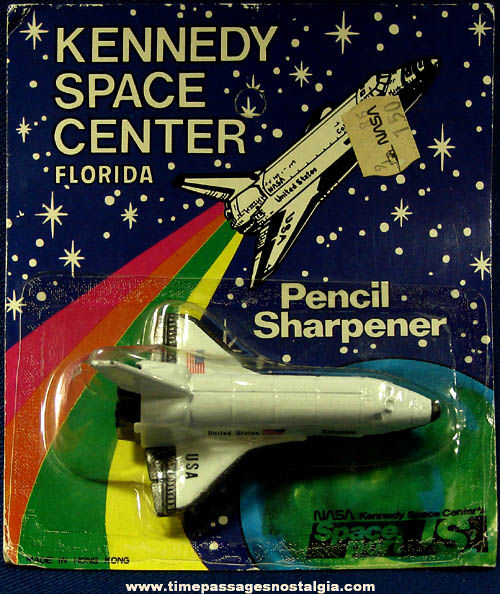
 | Item #d363 | 
Price: $24.99
$8 shipping & handling
For Sale
|
|
  | | | Any group of items being offered as a lot must be sold as a lot. | | Quantity Discount Prices
(when available) | All Original Items.
No Reproductions | Don't forget to
bookmark this site. | Whether you've collected Memorabilia for years or just want to feel like a kid again, please take a few moments to browse through what we
have available for sale. | | Quality Merchandise At Reasonable Prices |  | | We have an extensive inventory that is not yet on our web site. If there is something you are looking for and did not find, please send us your wish list. | | An Ever Changing Inventory |
| | | | The picture shows a view of this Old Unopened Columbia Space Shuttle Souvenir Pencil Sharpener. The packaging is not dated but it is believed to be from the late 1970s or early 1980s. It had been purchased and saved as a souvenir from the Kennedy Space Center in Florida. The Columbia Space Shuttle is known for it's fatal end when returning to Earth in 2003. The packaging shows the shuttle in flight trailing a rainbow. It still has it's original NASA price sticker. The package is marked as follows: KENNEDY SPACE CENTER
FLORIDA
PENCIL SHARPENER
NASA KENNEDY SPACE CENTER'S SPACE PORT
MADE IN HONG KONG To judge the sizes the package measures 5'' x 6-1/8''. The space shuttle is in mint unopened condition. The package has some light shelf wear on the corners as pictured. Below here, for reference is some information that was found online about the Space Shuttle Columbia: Space Shuttle Columbia
From Wikipedia, the free encyclopedia Columbia OV-102 OV Designation: OV-102
Country: United States
Contract award: July 26, 1972
Named after: Robert Gray’s Columbia Rediviva
First flight: STS-1 April 12, 1981 - April 14, 1981
Last flight: STS-107 January 16, 2003 – February 1, 2003
Number of missions: 28
Crews: 160
Time spent in space: 300.74 days
Number of orbits: 4,808
Distance travelled: 125,204,911 miles (201,497,772 km)
Satellites deployed: 8
Mir dockings: 0
ISS dockings: 0
Status: Destroyed February 1, 2003 Space Shuttle Columbia (NASA Orbiter Vehicle Designation: OV-102) was the first spaceworthy space shuttle in NASA's orbital fleet. Its first mission, STS-1, lasted from April 12 to April 14, 1981. On February 1, 2003, Columbia disintegrated during re-entry over Texas, on its 28th mission, killing all seven crew members. History
Construction began on Columbia in 1975 primarily in Palmdale, California. Columbia was named after the Boston, Massachusetts based sloop Columbia captained by American Robert Gray, who explored the Pacific Northwest and became the first American vessel to circumnavigate the world; the name also honored Columbia, the Command Module of Apollo 11. After construction, the orbiter arrived at John F. Kennedy Space Center on March 25, 1979, to prepare for its first launch. On March 19, 1981, during preparations for a ground test, five workers were asphyxiated during a nitrogen purge, resulting in five deaths. The first flight of Columbia (STS-1) was commanded by John Young (a space veteran from the Gemini and Apollo eras) and piloted by Robert Crippen, who had never been in space before, but who served as a support crew member for the Skylab missions and Apollo-Soyuz. It launched on April 12, 1981, the 20th anniversary of human spaceflight, and returned on April 14, 1981, after orbiting the Earth 36 times. Columbia then undertook three further research missions to test its technical characteristics and performance. Its first operational mission, with a four-man crew, was STS-5, which launched on November 11, 1982. At this point Columbia was joined by Challenger, which performed the next three shuttle missions. In 1983, Columbia undertook its second operational mission (STS-9), this time with six astronauts, including the first non-American astronaut on a space shuttle, Ulf Merbold. Columbia was not used for the next three years, during which time the shuttle fleet was expanded to include Discovery and Atlantis. Columbia returned to space on January 12, 1986, with the launch of STS-61-C. The mission's crew included Dr. Franklin R. Chang-Diaz, as well as the first sitting member of the House of Representatives to venture into space, Bill Nelson. The next shuttle mission was undertaken by Challenger. It was launched on January 28, 1986, ten days after STS-61-C had landed. The mission ended in disaster shortly after launch. In the aftermath NASA's shuttle timetable was disrupted, and Columbia was not flown again until 1988 (on STS-28), after which it resumed normal service as part of the shuttle fleet. STS-93, launched on July 23, 1999, was commanded by Lt. Col. Eileen Collins. Prototype orbiter
Columbia was roughly 8,000 lb (3,600 kg) heavier than subsequent orbiters such as Endeavour, which were of a slightly different design, and had benefitted from advances in materials technology. In part this was due to heavier wing and fuselage spars, the weight of early test instrumentation that remained fitted to the avionics suite, and an internal airlock that was not fitted to the other shuttles. Despite refinements to the launcher's thermal protection system and other enhancements, Columbia would never weigh as little unloaded as the other orbiters in the fleet. The next oldest shuttle, Challenger, was also relatively heavy, although 2,200 lb (1,000 kg). lighter than Columbia.
Externally, Columbia was the only orbiter in the fleet that had an all tile thermal protection system (TPS), although this was later modified to incorporate nomex felt insulation blankets on the fuselage and upper wing surfaces. The work was performed during Columbia's first retrofitting and the post Challenger stand down. Also unique to Columbia were the black ''chines'' on the upper surfaces of the shuttle's forward wing. These black areas were added because the first shuttle's designers did not know how reentry heating would affect the craft's upper wing surfaces.Until its last refit, Columbia was the only operational orbiter with wing markings consisting of an American flag on the left wing and the letters ''USA'' on the right. Challenger, Discovery, Atlantis, and Endeavour all until 1998 bore markings consisting of the letters ''USA'' afore an American flag on the left wing, and the pre-1998 NASA ''worm'' logo afore the respective orbiter's name on the right wing. From its last refit to its destruction, Columbia bore markings identical to those of its sister orbiters, the NASA ''meatball'' logo on the left wing and the American flag afore the ''Columbia'' designation on the right; Columbia's distinctive wing ''chines'' remained. Another unique external feature, termed the ''SILTS'' pod, was located on the top of Columbia's tailfin, and was installed after STS-9 to acquire infrared and other thermal data. Though the pod's equipment was removed after initial tests, NASA decided to leave it in place, mainly to save costs, along with the agency's plans to use it for future experiments. The tailfin was later modified to incorporate the drag chute first used on Endeavour in 1992. Internally, Columbia was originally fitted with Lockheed Martin built ejection seats identical to those found on the SR-71 Blackbird. These seats were active on the initial series of orbital test flights, but were deactivated after STS-4 and were removed entirely after STS-9. Columbia was also the only orbiter not delivered with heads up displays for the Commander and Pilot, although these were incorporated after STS-9. Like its sister ships, Columbia was eventually retrofitted (at its last refit) with the new MEDS ''glass cockpit'' display and lightweight seats. Unlike the other orbiters, Columbia retained an internal airlock, but was modified so that it could be fitted to accept the external airlock and docking adapter needed for flights to the International Space Station. This retention of an internal airlock allowed NASA to use Columbia for the STS-109 Hubble Space Telescope servicing mission, along with the Spacehab double module used on STS-107. If Columbia had not been destroyed, it would have been fitted with the external airlock/docking adapter for mission STS-118, an International Space Station assembly mission, in November 2003. After the STS-118 mission, Columbia’s career would have started to wind down. The shuttle was planned to service the Hubble Space Telescope two more times, once in 2004, and again in 2005, but no more missions were planned for it again until 2009 when, on STS-144, it would retrieve the Hubble Space Telescope from orbit and bring it back to Earth. Flights
Space Shuttle Columbia flew 28 flights, spent 300.74 days in space, completed 4,808 orbits, and flew 125,204,911 miles (201,497,772 km) in total, including its final mission. Columbia is the only shuttle to have been spaceworthy during the Shuttle Mir and International Space Station programs and yet to have never visited either Mir or ISS. In contrast, Discovery, Atlantis, and Endeavour have all visited both stations at least once. Challenger was destroyed before the Shuttle-Mir Program began, and Enterprise never flew in space. Final mission and destruction
On its final mission, Columbia carried a crew of seven astronauts: Rick Husband (Commander), Willie McCool (Pilot), Michael P. Anderson, Laurel B. Clark, David M. Brown, Israeli astronaut Ilan Ramon, and Kalpana Chawla. On the morning of February 1, 2003, the shuttle re-entered the atmosphere after a 16 day scientific mission. NASA lost radio contact at about 0900 EST, only minutes before the expected 0916 landing at Kennedy Space Center in Florida. Video recordings show the craft breaking up in flames over Texas, at an altitude of approximately 39 miles (63 km) and a speed of 12,500 mph (5.6 km/s). In the months following the tragedy, NASA scientists determined that a hole was punctured in the leading edge on one of Columbia's wings, made of a carbon-carbon composite. The hole had formed when a piece of insulating foam from the external fuel tank peeled off during the launch 16 days earlier, puncturing the edge of the wing. Hot gases, inaccurately described in initial reports as plasma, penetrated the interior of the wing, destroying the support structure and causing the rest of the shuttle to break apart during the intense heat of re-entry. Forensic analysis of the debris was conducted jointly with the Materials Science department of Lehigh University. The collected debris of the vessel is currently stored on the 16th floor of the Vehicle Assembly Building at the Kennedy Space Center; recovered items are occasionally loaned for research into the hypersonic flight regime. Former NASA Administrator Sean O'Keefe vowed that Columbia will not be sealed away as was the debris from the Challenger. The debris from Challenger is permanently entombed in two Minuteman missile silos at Cape Canaveral Air Force Station. Tribute
The shuttle's final crew was honored in 2003 when the USGS's Board of Geographic Names approved the name Columbia Point for a 13,980' mountain in Colorado's Sangre de Cristo Mountains. Not more than a half mile away lies Challenger Point, a peak named for America's other lost shuttle. The Columbia Hills on Mars were also named in honor of the crew, and a host of other memorials were dedicated in various forms. Fans of the original Star Trek television series were largely responsible for NASA naming the first Space Shuttle Enterprise. In the television series Star Trek: Enterprise both the first and second starships of the human built NX-Class were named in honor of pre-existing NASA space shuttles. The second starship's name was first revealed in the season 3 to be Columbia, in honor of the space shuttle Columbia following its destruction on February 1, 2003. Uniforms worn by crewmembers serving on this starship bore a patch similar to that on the uniforms worn by the space shuttle Columbia crewmembers, with 7 individual stars visible. Stars are often used on NASA mission insignias to represent the number of crewmembers. |
|
Click on image to zoom.
 |